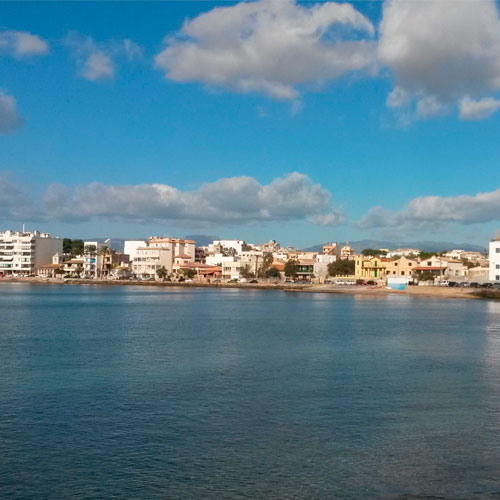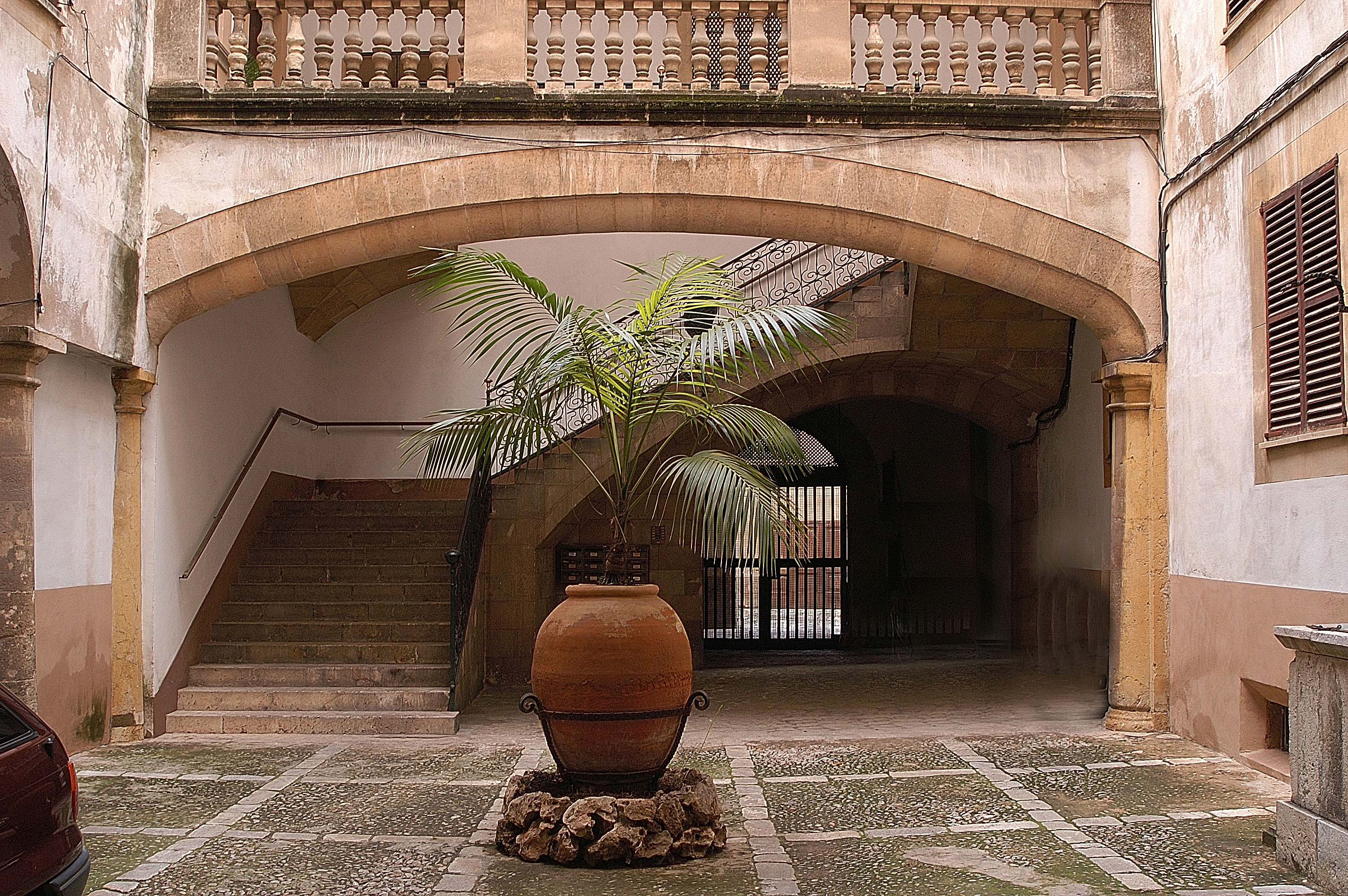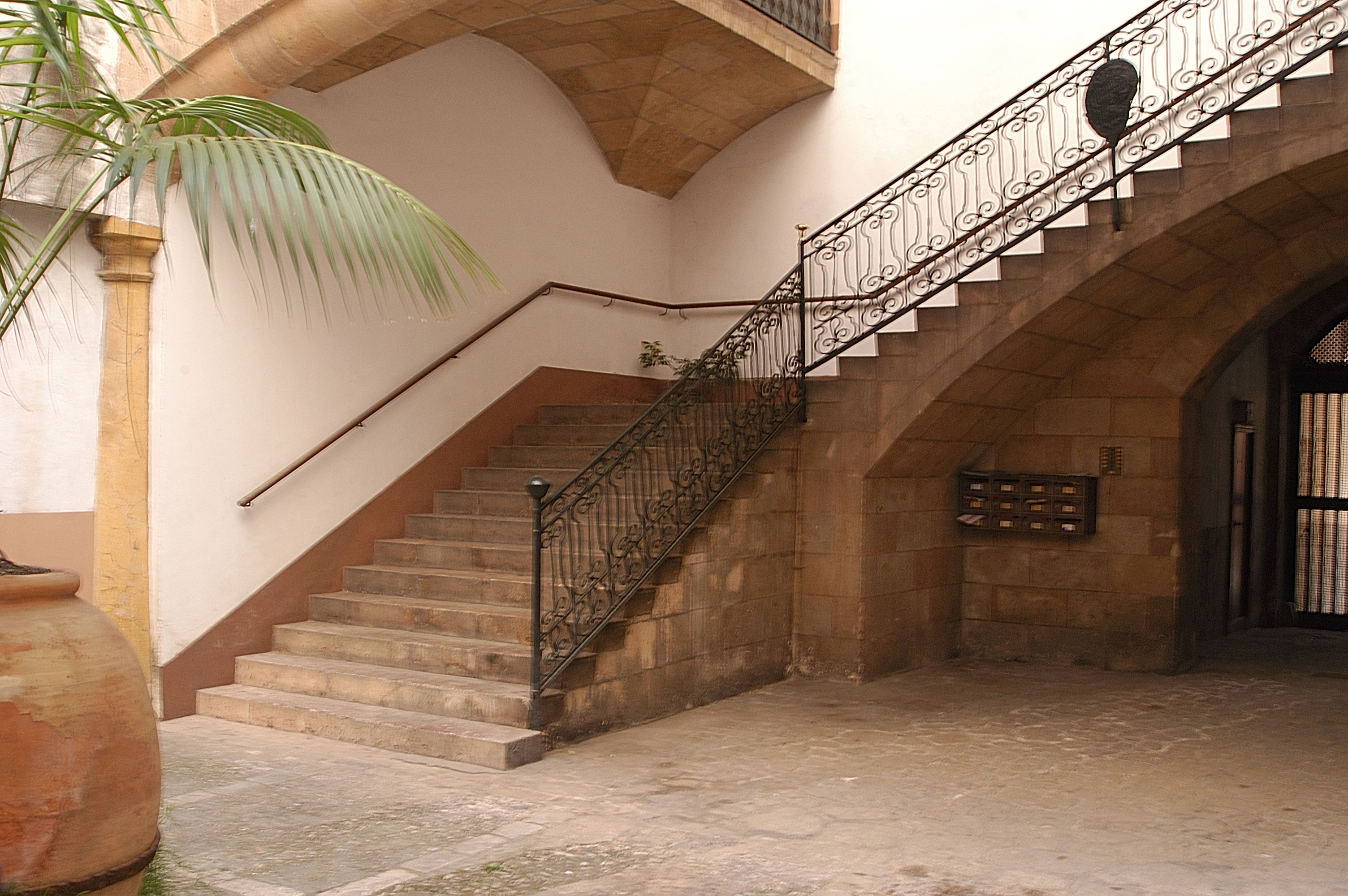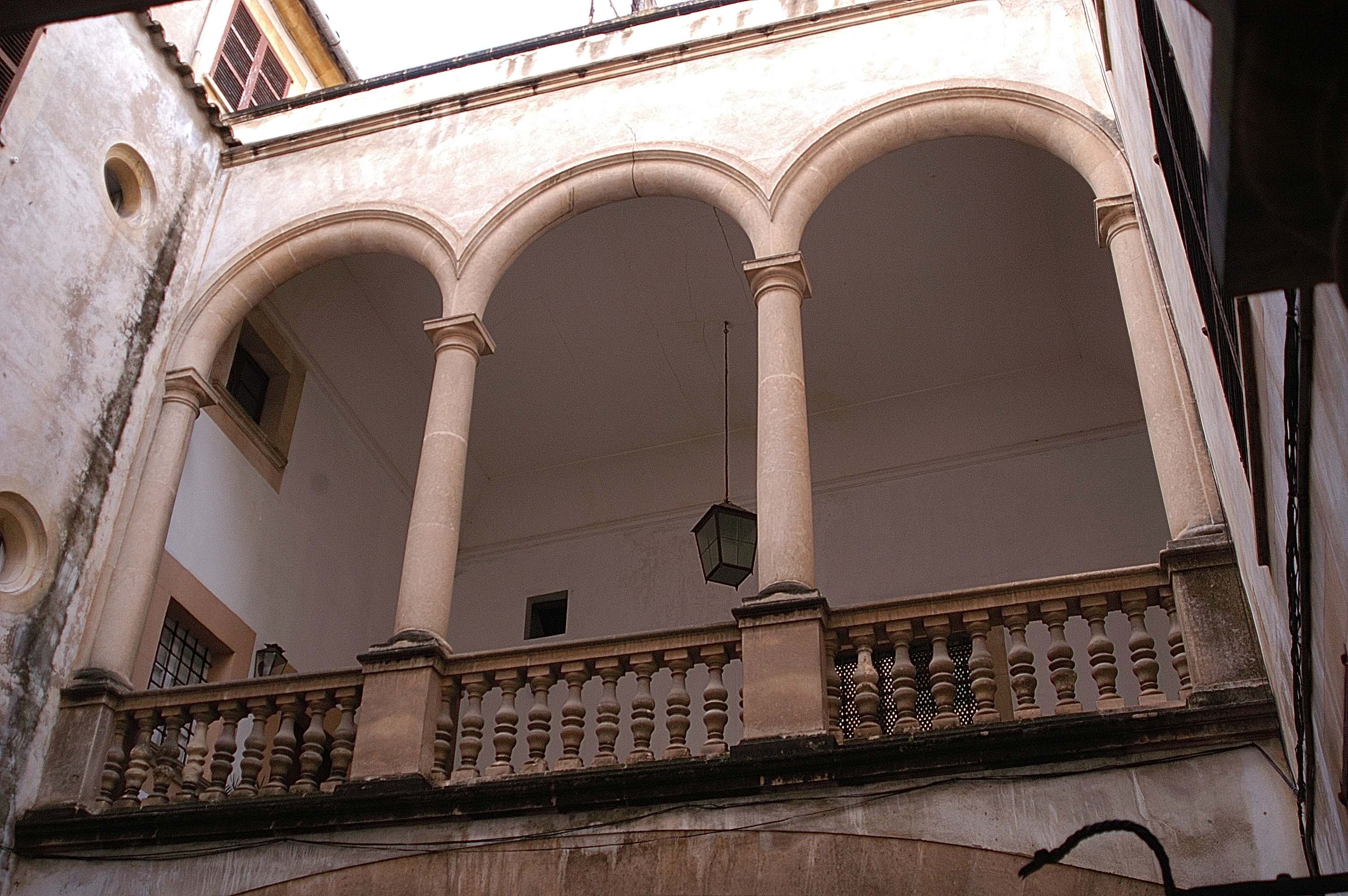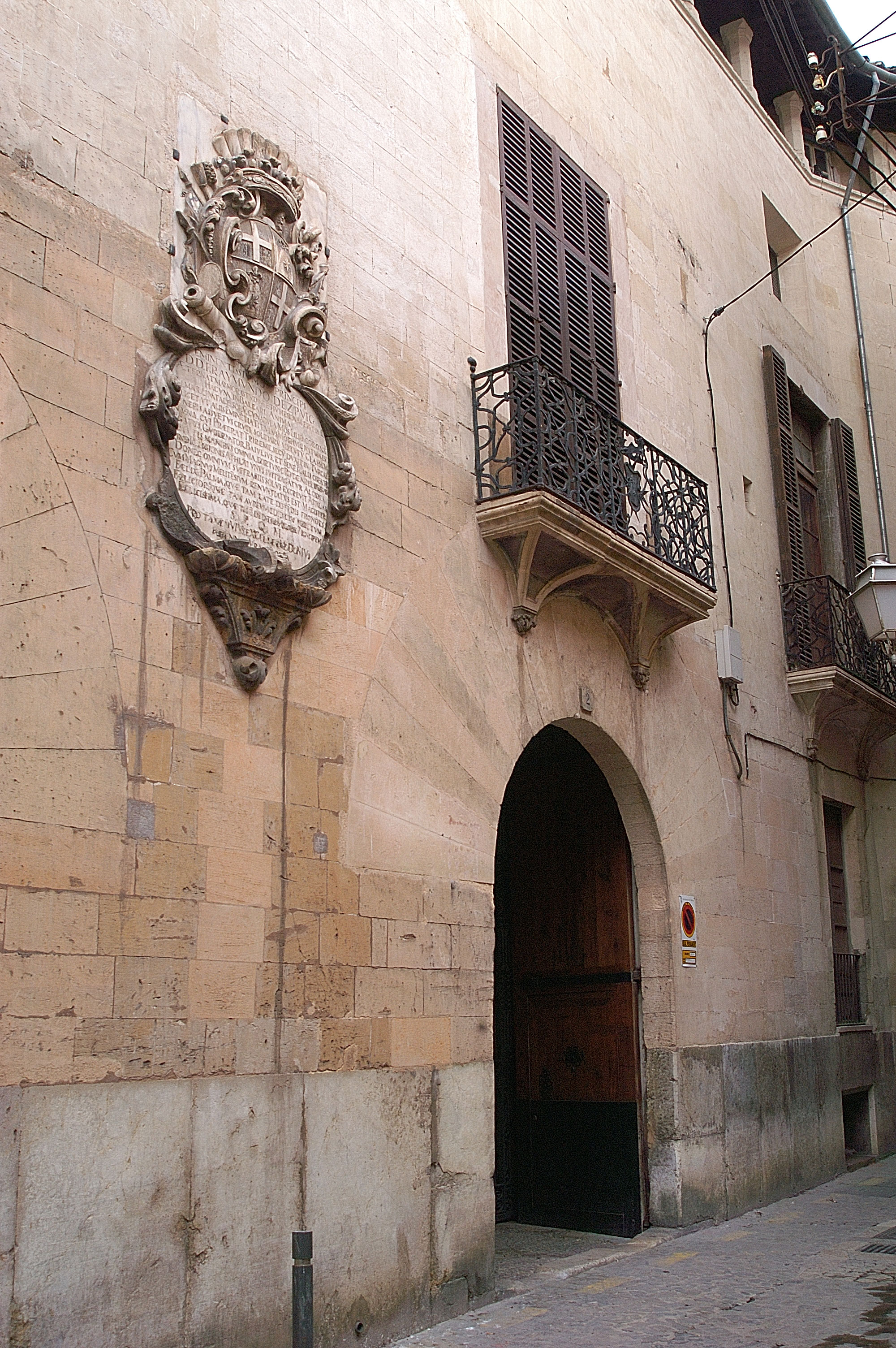Ca´n Montenegro - Tourism
Ca´n Montenegro
Description
The façade structure of the building, also known as Ca´n Despuig, shows the traditional division of three floors. The ground floor shows two vault-stone semicircular doorways. Between the two doors we find the coat of arms of the Despuig family, with an inscription that commemorates the appointment of Ramón Despuig Martínez de Marcilla as Grand Master of the San Juan de Malta order (1737). The noble floor has 5 stone balconies with a forged iron handrail. The porch displays a mixture of elements, with octagonal pillars in the centre, `ajimez´ windows with twin arched lights separated by a column to the left and conopial arches to the right.
The lobby, or entrance, is covered by a coffered wooden ceiling. A lowered arch supported by Tuscan columns leads to the small courtyard that has been subject to reforms. The lowered arches to the sides of the courtyard have been walled and the doric columns in Serlian style, embedded in a recently built wall. To the right we find a polygonal well built into the wall. In the back we see a further lowered arch that encloses the staircase. The staircase, that has a metallic handrail and displays the coat of arms of the Despuig family, leads up to the noble floor landing. The landing is open towards the courtyard through a gallery consisting of three semicircular arches supported by Tuscan columns and a balustrade in the lower part.
Historical Reference
In the year 1658, King Felipe IV granted Ramón Despuig Rocabertí, knight of the Calatrava Order and captain of the horses and the shields of the Kingdom of Mallorca, the title of Count of Montenegro. It was Ramón Despuig, by marriage with Melciora Martínez de Marcilla, who obtained the title of Count de Montoro for the Despuig house. One of the most outstanding characters of this family was Cardinal Antoni Despuig Dameto (1745-1813), erudite and important benefactor of the arts.
The building dates back to the XVth century. In the year 1576 it was owned by Miquel de Santjoan. At the beginning of the XVIIth century it became the ownership of the Despuig family. Some time later a further house was added to the house. This new house was owned by Garau Pont in the year 1576. Thorough reforms were performed that gave the whole building complex a Baroque touch.
According to the inventory made in the year 1627, time at which it became the ownership of Ramón Despuig Santmartí, the house had "a living room typical of the big houses, living room towards the street, a stable, a big room, a bedroom, a dressing room, a chapel, a house entrance, an oil shop beneath the living room, a chapel studio, a street studio, stables and a library" among other chambers. Since the times of Cardinal Despuig until the beginning of the XXth century, the house homed one of the most important collections of paintings and artistic objects of Mallorca.
According to the "amended electoral list" of the year 1864, the house was situated on block number 199 and was owned by Mr. Tomás Despuig Despuig "yeoman" with a quota of 25,258 pounds. Mr. Ramón Despuig Fortuny, "yeoman" with a quota of 20,312 pounds (AMP, 1060) lived on the same block of houses.
Literary Reference
- Gambús-Massanet, 1987, 93
- Murray-Pascual, 1999, p. 141-144
- Patis de Palma (Courtyards of Palma): Town Council of Palma - Baltar et al 2002, p. 109
- Valero, 2004, p. 182
- Catalogue of the Town Council of Palma, 2005.
George Sand and the map of Gabriel Valseca (A winter in Mallorca)
The writer George Sand (Paris 1804 - Nohant, France 1876) and the Polish composer Frederic Chopin lived on Mallorca between November 1838 until 13th February 1839; after staying some time at Son Vent (Establiments) they moved to the Carthusian monastery of Valldemosa, that had recently been disentailed. The book written by George Sand in which she describes her experiences on Mallorca, A Winter on Mallorca, was published in Paris in the year 1841.
The Ca´n Montenegro house, owned for centuries by the Despuig family, homed a major art collection as well as a highly interesting library. During the winter of 1838-1839, the writer George Sand visited the house. However, during her visit she witnessed an incident, which she herself describes, related with a nautic map designed by the Majorcan Gabriel Valseca. This map is a manuscript that dates back to the year 1439, a masterpiece of cartography and with topographic drawings that, at that time, was located at Ca´n Montenegro. George Sand describes her experience at Ca´n Montenegro, especially the incident she experienced with the map:
The most prestigious palace in Palma is that owned by Count of Montenegro, an 80-year old man who had been general captain, one of the most illustrious born characters and of major wealth of Mallorca. This Sir owns a library we were allowed to visit. However, I did not open a single book there. I would not be in the position to comment on it (due to my fear of books) should a very wise countryman not have informed me about the importance of the literary treasures I passed by with indifference, as the rooster did with the pearls in the tale. (...)
As I write this note, I shudder, since it reminds me of a terrible event. We were in the library of Montenegro's and the chaplain unrolled a nautic map in front of us, a precious, valuable and rare monument that had been bought by Americo Vespucci for 130 gold ducats and God knows how the enthusiast of antiquities, cardinal Despuig, had acquired it... one of the around forty or fifty servants of the house had the idea of placing a cork inkpot on one of the corners of the scroll to keep it unrolled on the table. The inkpot was full, full to the top! The scroll, used to being rolled up, and maybe impelled by a negative spirit at the time, made an effort, creaked, jumped, released itself from all obstacles, and rolled up, dragging along the inkpot that disappeared inside the scroll. A scream was heard: the chaplain turned paler than the scroll itself. They unrolled the map, still holding useless hope! What a tragedy! The inkpot was empty! The map was flooded and the beautifully portrayed miniature kings literally sailed a sea that was even blacker than Pont-Euxin. Everyone lost their nerves. I believe the chaplain fainted. The servants came to the rescue with water buckets, as in case of a fire. Armed with a sponge and broom they started to clean the map and swept the mishmash of kings, seas, islands and continents.
Source: Sand, G. 1992: 88-90 / Valero, G.: Palma ciutat de narrativa.
Date last modified: March 13, 2023


